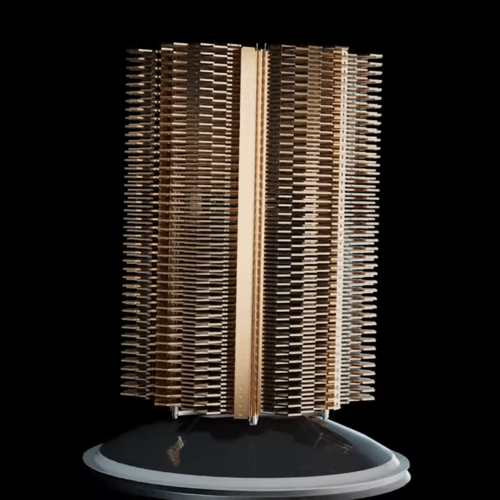Watch Live as SpaceX’s Private Fram2 Crew Returns From Polar Orbit
After splashdown, the crew will attempt to exit the vehicle without assistance to assess their physical capabilities.


Iâve always been fascinated by Microsoft, and itâs led me on a somewhat surreal path to covering the company for most of my life. It all started in my teenage years, when my curiosity over the inner workings of Windows led to brief moments of fame and lots of moments of trouble with Microsoftâs lawyers.
As a nerdy teenager in the early â00s I would spend hours building PCs to run prerelease versions of Windows, and I would regularly lug my custom machines and CRT monitors to house parties. I would DJ the latest MP3s I had downloaded from Napster and try to impress my friends with a secret new Windows feature they had never seen before.
While Windows rarely impressed my friends, my passion for unreleased Microsoft software really kicked up a gear with Windows XP. Codenamed Whistler, it was a big departure, visually, from Windows 2000 and Windows ME, and there was a lot to play around with during early beta builds.
Microsoft issued public builds of Windows XP in late 2000, but the really interesting parts were hidden away in the daily builds that Microsoftâs Windows engineers were working on. I wanted to get access to as many of these as possible, so I started to downlo …

Bill Gates celebrated Microsoft’s 50th Anniversary by sharing the source code that created the company’s foundation. The 157-page PDF available to download on Gates’ blog contains the origins of Altair Basic — a programming language interpreter for the MITS Altair 8800 microcomputer — and “remains the coolest code I’ve ever written to this day,” according to the Microsoft co-founder.
Altair Basic was developed by Gates, fellow Microsoft co-founder Paul Allen, and programmer Monte Davidoff. The trio reportedly coded “day and night for two months” in 1975. Personal computers were extremely rare, but after seeing the Altair 8800 on the cover of a magazine, Gates and Allen believed that enabling its chip to run a version of the Basic programming language would revolutionize the industry.
“We considered creating a similar tool called a compiler that translates the entire program and then runs it all at once,” Gates said on his blog. “But we figured the line-by-line approach of an interpreter would be helpful to novice programmers since it would give instant feedback on their code, allowing them to fix any mistakes that crop up.”
MITS decided to license the software from Gates and Allen, and Altair Basic became the first product under their new company Micro-soft. You can check out the full code document below or on Gates’ blog. Not only does it have some other details about the early history of Microsoft, but the web page UI has been designed with some funky animations and graphics that pay homage to the retro coding project.

General Timothy Haugh, the director of the National Security Agency and US Cyber Command, was fired on Thursday, according to a report from The Washington Post. His removal reportedly occurred just one day after right-wing activist Laura Loomer pushed for his firing during a meeting with President Donald Trump.
Wendy Noble, the Deputy Director and senior civilian leader of the U.S. National Security Agency, has also been fired and may have been moved to another role at the Pentagon, according to The New York Times.
“NSA Director Tim Haugh and his deputy Wendy Noble have been disloyal to President Trump,” Loomer wrote in a post on X. “That is why they have been fired.” Loomer said Haugh was “hand picked” by General Mark Milley, who butted heads with Trump during his first term. “Why would we want an NSA Director who was referred to Biden after being hand selected by Milley,” Loomer wrote.
Former President Joe Biden nominated Haugh in 2023. He spent more than 30 years in the military and led the Cyber Command’s Cyber National Mission Force.
It is astonishing that President Trump would fire the nonpartisan leader of the NSA while still failing to hold any member of his team accountable for leaking classified information on Signal – even as he apparently takes staffing direction from a discredited conspiracy theorist in the Oval Office.
— Senator Mark Warner (@markwarner.bsky.social) 2025-04-04T03:03:05.183Z
Democrats on the Intelligence Committee criticized Haugh’s ousting. “It is astonishing that President Trump would fire the nonpartisan leader of the NSA while still failing to hold any member of his team accountable for leaking classified information on Signal – even as he apparently takes staffing direction from a discredited conspiracy theorist in the Oval Office,” Senator Mark Warner (D-VA) said in a post on Bluesky. Representative Jim Himes (D-CT) said in a statement to The Post he was “deeply disturbed” by Haugh’s removal.
Lieutenant General William J. Hartman, who served as the Cyber Command Deputy, has been named the acting director of the NSA, while NSA executive director Sheila Thomas was appointed acting deputy, according to The Post.

In 2005, Microsoftâs leaders were starting to get worried. Windows and Office were doing well, but the companyâs lead software architect, Ray Ozzie, warned them that an emerging trend threatened Microsoft’s very existence.
“A new business model has emerged in the form of advertising-supported services and software,” warned Ozzie in his famous memo. “This model has the potential to fundamentally impact how we and other developers build, deliver, and monetize innovations.”
Ozzie wanted Microsoft to get ready for the web-based world and cloud computing, fearing the company would otherwise be left behind. In the years after Ozzie’s memo, Google started to build an online competitor to Office with its Google Docs web service that it was selling to businesses and offering free to consumers. But the idea of moving Office to the cloud remained controversial internally. Doing so would upend Microsoftâs traditional method of selling software â and potentially eat into short-term profits in a big way.
âIt was a gutsy call, it wasnât a popular call at Microsoft at that time,â says Rajesh Jha, executive vice president of Microsoftâs experiences and devices group. Steve Ballm …





Outside of several mentions in the Rocket Report newsletter dating back to 2018, Ars Technica has not devoted too much attention to covering a novel California space company named SpinLaunch.
That's because the premise is so outlandish as to almost not feel real. The company aims to build a kinetic launch system that spins a rocket around at speeds up to 4,700 mph (7,500 km/h) before sending it upward toward space. Then, at an altitude of 40 miles (60 km) or so, the rocket would ignite its engines to achieve orbital velocity. Essentially, SpinLaunch wants to yeet things into space.
But the company was no joke. After being founded in 2014, it raised more than $150 million over the next decade. It built a prototype accelerator in New Mexico and performed a series of flight tests. The flights reached altitudes of "tens of thousands" of feet, according to the company, and were often accompanied by slickly produced videos.


© SpinLaunch

For two decades, farmer John Burk has been working to improve the soil on his farm in Michigan, taking a few extra steps to make it more resilient and productive. His efforts have paid off.
“When we have the dry, hot summers or lack of rainfall, our crops can sustain the dry spells better. We don’t have huge yield decreases,” Burk said. “And when it rains and we have the freak storms, like it seems to do so much now, we don’t have the ponding and all the runoff.”
An added bonus: He needs less fertilizer, a major operating expense.


© https://www.gettyimages.com/detail/photo/wind-farms-and-agricultural-production-royalty-free-image/2183669700




Fifty years ago today, Micro-Soft was founded by friends Bill Gates and Paul Allen. As the name implies, Microsoft was originally focused on microprocessors and software, and Gates and Allen created the company to develop software for the Altair 8800, an early personal computer.
Founded on April 4th, 1975, Microsoft went on to strike a deal with IBM to provide software for its first PC in 1980. This became the foundation of MS-DOS, which dominated IBM-compatible PCs during the ’80s. Microsoft’s early success in developing software for PCs eventually led to the first version of Windows in 1985 and a dream of a PC on every desk and in every home.
That early Windows GUI on top of MS-DOS quickly progressed into an even more capable operating system with the launch of Windows 95. The highly-anticipated version of Windows launched at midnight, with fans lining up at stores to get boxed copies of Windows 95 to install on their PCs. Windows 95 introduced many parts of Windows that we still use today, including the familiar desktop, File Explorer, My Documents area, and Recycle Bin.
While Microsoft was improving Windows with every release, it was also developing a variety of productivity apps throughout the 1980s that would soon become the company’s Office suite. Launched originally in 1989 for the Mac, Office quickly became an important productivity suite on Windows that even runs inside a web browser these days. Office and Windows are now used by billions of people every day, making Microsoft one of the most valuable tech companies in the world.
Microsoft’s success with Windows and Office has allowed the company to expand in many directions over the past 50 years, including the launch of the Xbox game console in 2001, the Azure cloud push in 2008, and even the Bing search engine launch in 2009.
Microsoft has also experimented with a variety of hardware over the years, but its most successful device lineup has come in the form of Surface, which originally launched in 2012 alongside Windows 8. Surface has served as a vehicle to demonstrate the best of Windows and Office, and it’s quickly becoming a test bed for Microsoft’s AI ambitions on the PC.
Microsoft’s next 50 years look increasingly focused on an AI transformation it’s in the middle of building toward. It has the potential to overhaul Windows, Office, Azure, and practically every business that Microsoft has built over the decades.
Microsoft is celebrating its 50-year anniversary today during a special event at the company’s headquarters in Redmond, Washington. The software maker will unveil new Copilot features, and we’re expecting to see familiar faces from the past and present of Microsoft to reflect on the company’s 50 years and the future of this tech giant.

Microsoft was originally founded on April 4th, 1975, and the tech giant is now celebrating its 50-year anniversary. Microsoft started with a focus on personal computers, building the very software that helped it achieve an early goal of a PC on every desk and in every home.
The success of Windows and Office has allowed Microsoft to launch devices like the Xbox and Surface line and transform its business into software and services in the cloud. Now, Microsoft looks ahead to its next 50 years in a period of AI that could transform everything it does.
Follow along for our coverage of Microsoft’s 50 years, the company’s celebrations, and what’s next for one of the world’s most valuable tech companies.
Fintech startup Plaid has raised $575 million in a new funding round that puts its valuation at $6 billion—less than half of its 2021 peak of $13.4 billion. The new round gives employees a way to cash out their equity, […]
The post Plaid raises $575M at $6B valuation, down from $13.4B peak, letting employees cash out amid IPO delay first appeared on Tech Startups.